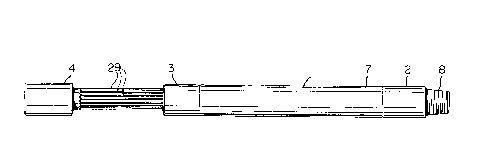Une partie des informations de ce site Web a été fournie par des sources externes. Le gouvernement du Canada n'assume aucune responsabilité concernant la précision, l'actualité ou la fiabilité des informations fournies par les sources externes. Les utilisateurs qui désirent employer cette information devraient consulter directement la source des informations. Le contenu fourni par les sources externes n'est pas assujetti aux exigences sur les langues officielles, la protection des renseignements personnels et l'accessibilité.
L'apparition de différences dans le texte et l'image des Revendications et de l'Abrégé dépend du moment auquel le document est publié. Les textes des Revendications et de l'Abrégé sont affichés :
| (12) Brevet: | (11) CA 1335877 |
|---|---|
| (21) Numéro de la demande: | 1335877 |
| (54) Titre français: | METHODE D'ESSAI D'UN PUITS DE PETROLE, ET APPAREIL CONNEXE |
| (54) Titre anglais: | APPARATUS AND METHOD FOR TESTING A WELL |
| Statut: | Périmé et au-delà du délai pour l’annulation |
| (51) Classification internationale des brevets (CIB): |
|
|---|---|
| (72) Inventeurs : |
|
| (73) Titulaires : |
|
| (71) Demandeurs : | |
| (74) Agent: | LAMBERT INTELLECTUAL PROPERTY LAW |
| (74) Co-agent: | |
| (45) Délivré: | 1995-06-13 |
| (22) Date de dépôt: | 1988-09-30 |
| Licence disponible: | S.O. |
| Cédé au domaine public: | S.O. |
| (25) Langue des documents déposés: | Anglais |
| Traité de coopération en matière de brevets (PCT): | Non |
|---|
| (30) Données de priorité de la demande: | S.O. |
|---|
In general, pumps for use in oil wells are
complicated structures which are difficult to produce and/or
install. A simple pump, which can readily be incorporated in
a well string includes a tubular barrel, a bottom sub carrying
a fixed valve on the lower end of the barrel, an internally
splined sleeve on the supper end of the barrel, and a splined
plunger carrying a second, moving valve slidable in the sleeve
and barrel. Reciprocation of the plunger causes alternate
simultaneous opening of the bottom valve and closing of the
top valve, and closing of the bottom valve and opening of the
top valve to pump fluids up the well string. The valves are
structurally similar and each contains two valves for a tight
seal and efficient operation.
Note : Les revendications sont présentées dans la langue officielle dans laquelle elles ont été soumises.
Note : Les descriptions sont présentées dans la langue officielle dans laquelle elles ont été soumises.

2024-08-01 : Dans le cadre de la transition vers les Brevets de nouvelle génération (BNG), la base de données sur les brevets canadiens (BDBC) contient désormais un Historique d'événement plus détaillé, qui reproduit le Journal des événements de notre nouvelle solution interne.
Veuillez noter que les événements débutant par « Inactive : » se réfèrent à des événements qui ne sont plus utilisés dans notre nouvelle solution interne.
Pour une meilleure compréhension de l'état de la demande ou brevet qui figure sur cette page, la rubrique Mise en garde , et les descriptions de Brevet , Historique d'événement , Taxes périodiques et Historique des paiements devraient être consultées.
| Description | Date |
|---|---|
| Exigences relatives à la révocation de la nomination d'un agent - jugée conforme | 2020-04-22 |
| Exigences relatives à la nomination d'un agent - jugée conforme | 2020-04-22 |
| Le délai pour l'annulation est expiré | 2009-06-15 |
| Inactive : Demande ad hoc documentée | 2008-08-22 |
| Lettre envoyée | 2008-06-13 |
| Inactive : CIB de MCD | 2006-03-11 |
| Inactive : CIB de MCD | 2006-03-11 |
| Accordé par délivrance | 1995-06-13 |
| Déclaration du statut de petite entité jugée conforme | 1988-09-30 |
Il n'y a pas d'historique d'abandonnement
| Type de taxes | Anniversaire | Échéance | Date payée |
|---|---|---|---|
| TM (catégorie 1, 2e anniv.) - petite | 1997-06-13 | 1997-06-05 | |
| TM (catégorie 1, 3e anniv.) - petite | 1998-06-15 | 1998-05-22 | |
| TM (catégorie 1, 4e anniv.) - petite | 1999-06-14 | 1999-04-21 | |
| TM (catégorie 1, 5e anniv.) - petite | 2000-06-13 | 2000-05-18 | |
| TM (catégorie 1, 6e anniv.) - petite | 2001-06-13 | 2001-04-24 | |
| TM (catégorie 1, 7e anniv.) - petite | 2002-06-13 | 2002-06-11 | |
| TM (catégorie 1, 8e anniv.) - petite | 2003-06-13 | 2003-06-09 | |
| TM (catégorie 1, 9e anniv.) - petite | 2004-06-14 | 2004-03-16 | |
| TM (catégorie 1, 10e anniv.) - petite | 2005-06-13 | 2005-03-22 | |
| TM (catégorie 1, 11e anniv.) - petite | 2006-06-13 | 2006-06-08 | |
| TM (catégorie 1, 12e anniv.) - petite | 2007-06-13 | 2007-06-11 |
Les titulaires actuels et antérieures au dossier sont affichés en ordre alphabétique.
| Titulaires actuels au dossier |
|---|
| KAARE IDLAND |
| Titulaires antérieures au dossier |
|---|
| S.O. |